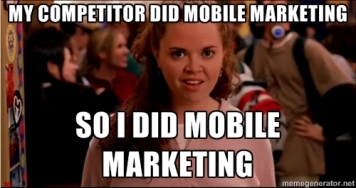The online Business Dictionary defines Integrated Marketing Communications (IMC) as “an approach to achieving the objectives of a marketing campaign through a well coordinated use of different promotional methods that are intended to reinforce each other.”
A good IMC campaign is integral to the success of a brand. But a bad campaign can damage or even destroy it. Need evidence, just go here for examples like #McDstories, where it was all too easy for the public to highlight the not so favourable side of McDonalds, or the Malaysia Airlines ‘Bucket List’!!!??? campaign, which distastefully followed 2 major disaster’s for the airline in which many people died.
Luckily the brilliant minds over at at CIO Magazine have developed an easy-to-follow, 7-step guide, on how to develop an IMC campaign which does not suck and which takes into account the intricacies of today’s diverse digital marketing landscape.
I give you: The Super, Amazing, Almost-Failsafe Guide to Not-Sucking at an IMC Campaign:
1. Know your target audience
This goes without saying. But don’t just make small talk on the issue, REALLY get to know them. What are their attitudes? Interests? Behaviours? Motivations? Communication preferences? Channel preferences? Social media behaviours?
Basically you want to know how, where and when to reach them.
2. Decide on your channels
a) ^ See above points
b) Refer to your objectives
c) Analyse each channel’s strengths and weaknesses with respect to a) & b)
d) Pick a channel
3. Embrace ‘one look’
Despite Zoolander’s initial reservations, you can and should embrace ‘one look’. Your messages should be instantly traceable to your brand through the overarching look, feel and design that you consistently convey in your messages.
4. Be clear, compelling and consistent
Marketing messages need to be clear to the consumer perceiving them, or they will not be attended to and encoded. They must be compelling and interesting to the consumer so that they are remembered. Compelling campaigns go viral, boring ones do not! Messages must also be consistent across different channels and with past messages.
5. I is for Integrate … do it!
There is no point engaging in marketing communication unless it is ALL working towards some common goal, whether that be to drive consumers to a site or get them to sign up for a service. When all your communication is working as one your results will also increase as there should be synergy between message channels.
6. Work as a team
To make sure that everything is integrated the marketers sending out the messages must be working together. Often some marketing occurs in house whereas other work is outsourced. This is fine as long as the common themes and goals of communication are understood by all.
7. Keep on track
How do you ensure that all the above is happening and that the results are working for you? You track ….. everything! You analyse your plan, refer to the objective results and then you you tweak it.
Google analytics can be a particularly useful tool to measure click through rates and see how various digital channels are fairing against one another. You can download a how to guide to help you use google analytics here.
How do you ensure that all the above is happening and working well? You track… everything! You analyse what you’re doing, see what is working and what is not, and tweak your IMC plan as so. Google analytics (click here for a how to guide) can be a particularly useful tool to measure click through rates and see how various digital channels are fairing against one another.
Hopefully this has explained a little of what IMC in a rapidly changing marketing environment entails. Have you seen any particularly good IMC campaigns? Some communication disasters? Let me know in a comment below.
Thanks for reading!














